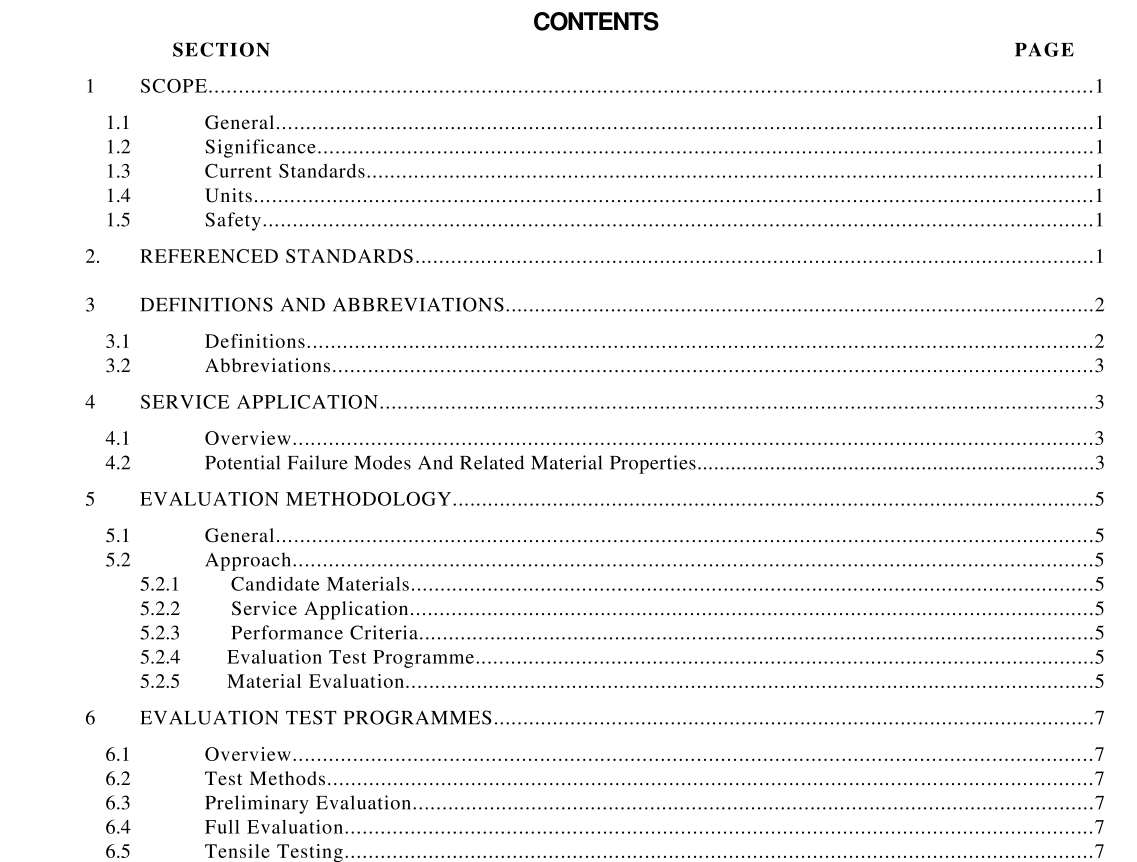API TR 17TR1 pdf download

API TR 17TR1 pdf download.Evaluation Standard for Internal Pressure Sheath Polymers for High Temperature Flexible Pipes
1 SCOPE
1 . 1 GENERAL 1 .1 .1 This technical report defines the methodology and test procedures necessary for the evaluation of polymeric materials suitable for use as the internal pressure sheath of an unbonded flexible pipes in high temperature applications. It describes the processes by which the critical material properties, both static and dynamic, can be measured and evaluated against relevant performance criteria. 1 .1 .2 This document relates primarily to the properties necessary for an internal pressure sheath required for oil and gas production. These are most relevant to high temperature applications. Only thermoplastic materials are considered for the internal pressure sheath. Elastomeric materials, which are used in bonded flexible pipes, are not considered in this document.1 . 3 CURRENT STANDARDS 1 .3.1 The current standards which relate to the evaluation of polymers for internal pressure sheath applications are: i) API Specification 17J, “Specification for Unbonded Flexible Pipe,” First Edition [1], ii) API Recommended Practice 17B “Recommended Practice for Flexible Pipe,” Second Edition [2]. 1 .3.2 These documents address all aspects of unbonded flexible pipe technology relevant to current levels of high temperature service; that is, to 130°C. 1 . 4 UNITS Système International (SI) units are used in this evaluation standard. Imperial units may be given in brackets after the SI units. 1 . 5 SAFETY The procedures described in this evaluation standard include materials tests requiring the use of high temperature and high pressure conditions, often with hostile chemicals. It is the responsibility of individuals or organisations using the standard to ensure that all appropriate safety procedures are implemented to prevent injuries to personnel and/or damage to equipment or facilities.
3 DEFINITIONS AND ABBREVIATIONS
3. 1 DEFINITIONS For the purposes of this standard, the following definitions apply: 3.1 .1 Flexible Pipe: An assembly of a pipe body and end fittings. The pipe body comprises a composite of layered materials (polymeric and metallic) that form a pressure containing conduit. The pipe structure allows large deflections without a significant increase in bending stresses. The term “pipe” is used in this document as a generic term for unbonded flexible pipe. 3.1 .2 Conventional Flexible Pipe: An unbonded flexible pipe which is suitable for internal fluid temperatures of up to 130°C. 3.1 .3 High Temperature Flexible Pipe: An unbonded flexible pipe which is suitable for internal fluid temperatures of between 130 and 200°C. 3.1 .4 Internal Pressure Sheath: The innermost contiguous polymeric layer of an unbonded flexible pipe, designed to contain transported fluids and ensure pipe integrity. 3.1 .5 Candidate Polymer: A polymeric material which is proposed for use as the internal pressure sheath of an unbonded flexible pipe and is being submitted for evaluation testing. 3.1 .6 End Fitting: A mechanical device which forms the transition between the flexible pipe body and the connector. The different pipe layers are terminated in the end fitting in such a way as to transfer the load between the flexible pipe and the connector. 3.1 .7 Test Temperature, Test Pressure: The temperature (T) and pressure (P) at which a test is to be run for the purposes of evaluating a candidate polymer. The choice of test temperature/pressure will depend only on the performance requirements for the proposed application. 3.1 .8 Test Result: The outcome of a materials test. This may be in the form of a physical quantity (e.g., Young’s modulus) or a subjective rating (e.g., blister damage).3.1 .9 Maximum Property Temperature (MPT): The maximum temperature for which a specified property meets the performance criterion; for example, if a candidate polymer swells 50% in oil at 165°C, but only 1% at 160°C, its MPT (for compatibility with the oil) is 160°C, assuming that 1% volume swell has been defined as acceptable for the application. See Figure 1. 3.1 .1 0 Maximum Service Temperature (MST): The maximum temperature for which all measured properties meet the specified performance criteria. In practice, there is little point in testing above the rapid gas decompression (RGD) MPT (other than when conducting accelerated ageing based on another property). If the MPT value of another property is lower then it will give the MST. For example, if a candidate polymer has the following MPTs – RGD (190°C), tensile (>190°C), crack growth fatigue (165°C), liquid compatibility in three different fluids (180°C, >190 °C, 170°C) – then the MST for the material is defined by the lowest MPT, that is, 165°C. See Figure 2. It is implicit that MST is significantly below candidate polymer melting point.









